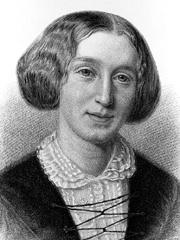Throughout all of Eliot's major texts, it becomes apparent that she employs the detailed analysis used in scientific investigation to observe moral, social, and medical phenomena. Eliot uses science as a form of realism; in imitating scientific methods and theories within her texts she is able to accurately portray the true nature of the world and the people within in it.
Scientific Processes
On 25 January 1876, George Eliot wrote a letter to Dr Joseph Frank in which she claimed her writing was 'simply a set of experiments in life'. Eliot's depiction of her work as an 'experiment' illustrates her awareness of scientific vocabulary, and suggests that a process of observation, analysis, and scientific precision forms the foundation of her texts. This formula for writing, endorsed by Eliot, serves to unite the scientific procedures of the Victorian era with her works of realism.
One such example of the unification between procedure and narrative occurs in Middlemarch - the novel considered Eliot's greatest - when the process of scientific research is directly alluded to through the narrator's description of Dr Lydgate's medical ambition: 'He was enamoured of that arduous invention which is the very eye of research'. Lydgate's motivation is aligned with the ambition that drives scientific experiments and research.
In her 1856 essay 'Silly Novels by Lady Novelists', Eliot dismisses the romantic and sentimental themes predominant throughout novels written by female authors in the nineteenth century. She again draws upon a scientific metaphor to identify and underline good writing:
'Like crystalline masses it may take any form, and yet be beautiful; we
have only to pour in the right elements – genuine observation, humour,
and passion'.
Her statement suggests that, according to Eliot, literary realism is achieved through diligent observation; a process which carefully imitates scientific procedure.
Phrenology
Science surrounded George Eliot for much of her adult life. She was greatly interested in the practice of Phrenology, and in the summer of 1844, went to London to have her head 'cast' by the eminent phrenologist James Deville. Phrenologists believed that each area of the brain was responsible for a different element of human personality, and that an individual's character could be estimated by the size and shape of the skull.

George Combe's The Constitution on Man (1835) was a hugely popular and influential text on phrenology in which Combe's claimed: 'We are physical, organic, and moral beings, acting under general laws'. George Eliot embraced this theory, which placed humans as part of a biological continuum twenty years before the publication of Charles Darwin's Origin of Species.
Natural Science
Eliot's partner George Henry Lewes, wrote his scientific text Physiology of Common Life whilst she was working on what was to become her best-selling novel, Adam Bede (1859). The definition of science that Lewes offers there resonates within the text of Eliot's first full-length novel, evident in her frequent use of metaphors drawn from natural science. As the narrator notes in Adam Bede:
'But we get accustomed to mental as well as bodily pain, without for all
that, losing our sensibilities to it: it becomes a habit or our lives, and
we cease to imagine a condition of perfect ease possible for us. Desire is
chastened into submission….it is at such periods that the sense of our lives
having visible and invisible relations beyond any of which either our
present or prospective self is the centre, grows like a muscle that we are
obliged to lean on and exert'.
Eliot uses the physiological description of a muscle to make physical the immaterial mental process, and remind us of the physiological dimension of thought processes; this being the brain as the organ of the mind. Biology, the self, and society are all linked through this scientific metaphor.
Another example of Eliot's use of powerful, scientific metaphor occurs in Middlemarch, when Dorothea's gaze is caught by the red fabric hung in St Peter's basilica. Eliot renders the image as quite literally eye catching, the image holding Dorothea's eye to then 'spread itself everywhere like a disease of the retina'.
Consciousness and Perception
Eliot makes use of the vocabulary of consciousness before it was made popular in the early twentieth century. Her novella The Lifted Veil (1859) uses the language of nineteenth-century science to engage with the concept of perception and consciousness. Through Latimer's extrasensory powers, which Eliot called 'double consciousness' – he is able to see his own death and hear the thoughts of those around him - the danger of only perceiving the foibles of others rather than their good qualities, and the problems that arise through too great an awareness of other people are investigated.
Latimer describes the oppressiveness of being able to hear the thoughts of not only strangers, but friends and family too:
'[…]when the rational talk, the graceful attentions, the wittily-turned
phrases, and the kindly deeds, which used to make the web of their
characters, were seen as if thrust asunder by a microscopic vision, that
showed all the intermediate frivolities, all the suppressed egoism, all the
struggling chaos of puerilities, meanness, vague capricious memories, and
indolent make-shift thoughts, from which human words and deeds emerge like
leaflets covering a fermenting heap'.
Eliot's manipulation of consciousness in The Lifted Veil means that her characters are not reducible to materialism. Sympathy for others is the quintessence of moral behaviour, and Latimer's knowledge is thereby only partial because, due to his ability to see all, he is disgusted by others and without sympathy. Ignorance has its merits. As this famous narrative interruption from Middlemarch states:
'If we had a keen vision and feeling of all ordinary human life it would be
like hearing the grass grow and the squirrel’s heart beat and we should die
of that roar that lies on the other side of silence. As it is, the quickest
of us walk about well-wadded in stupidity'.

